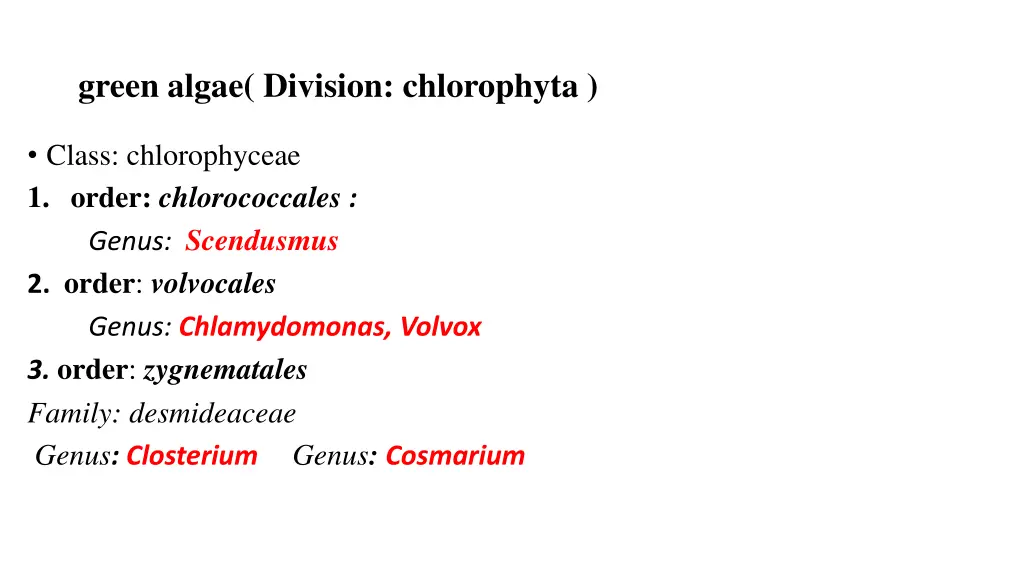
Unique Characteristics of Green Algae in Chlorophyta Division
Discover the fascinating world of green algae in the Chlorophyta division, showcasing various genera like Scendusmus, Chlamydomonas, Volvox, Closterium, and Cosmarium. Explore their general characteristics, unique structures, and reproductive features. Dive into the diverse forms of these algae, from solitary cells to filamentous colonies, and learn about their chloroplasts, flagellated stages, and cell wall composition. Witness the motility of Chlamydomonas and Volvox, the plate-like colonies of Scendusmus, and the distinctive shapes of Closterium and Cosmarium within the Desmideaceae family.
Download Presentation

Please find below an Image/Link to download the presentation.
The content on the website is provided AS IS for your information and personal use only. It may not be sold, licensed, or shared on other websites without obtaining consent from the author. If you encounter any issues during the download, it is possible that the publisher has removed the file from their server.
You are allowed to download the files provided on this website for personal or commercial use, subject to the condition that they are used lawfully. All files are the property of their respective owners.
The content on the website is provided AS IS for your information and personal use only. It may not be sold, licensed, or shared on other websites without obtaining consent from the author.
E N D
Presentation Transcript
green algae( Division: chlorophyta ) Class: chlorophyceae 1. order: chlorococcales : Genus: Scendusmus 2. order: volvocales Genus: Chlamydomonas, Volvox 3. order: zygnematales Family: desmideaceae Genus: Closterium Genus: Cosmarium
General characteristics The simplest algae occurring essentially as solitary cells or be aggregated into plate like or globular colonies. or occurring as filamentous form. Surrounded by thin mucilage layer 1- Contain chlorophyll type A and B. 2- Contain accessory pigments: xanthophyll, carotenoid (B-carotene) 3- Chloroplast is present and vary in shape, size and number. 4- Chlorophyta store their food as (pyrenoids) in chloroplast. 5- Flagellated stages are present 6- Sexual reproduction is present. in addition to asexual and vegetative reproduction. 7- The structural part of cell wall mainly consists of cellulose.
Chlamydomonas unicellular alga motile by two anterior flagella cup shape chloroplast which has a single large pyrenoid. eye spot (stigma) present in the anterior portion of the chloroplast for photosensitivity
Volvox spherical colonies with hollow center (hollow ball). the cells are similar to Chlamydomonas , these cells are embedded within mucoid matrix colony motile ,this motility derived from the flagellated individual cells. there are specialized cells within Volvox colony: a-vegetative cells: (most of colony cells specialized for nutrition ,movement) b -generative cells: 1.gonidia :larger but fewer than somatic cells, specialized for asexual reproduction through producing daughter colonies 2.antheridia: specialized for sexual reproduction through producing male swimmers(male gametes) 3.Oogonia: larger and fewer in number than antheridia. specialized for sexual reproduction through producing ovum (female gametes).
Scendusmus Plate-like cells (usually 4 or 8) aggregated parallel to one another to form a colonies ,The colonies ends are surrounded by fork-like appendages
Family: Desmideaceae Genus: Closterium 1-unicellular desmids consisting of two semi cells joined at an isthmus. with central nucleus and chloroplast in each semi cell. 2-reproduce by simple division and sexually by conjugation Closterium is characterized with crescent shape.
Cosmarium Cosmarium It has a central nucleus and two chloroplasts in each semi cell, each with a central pyrenoid
